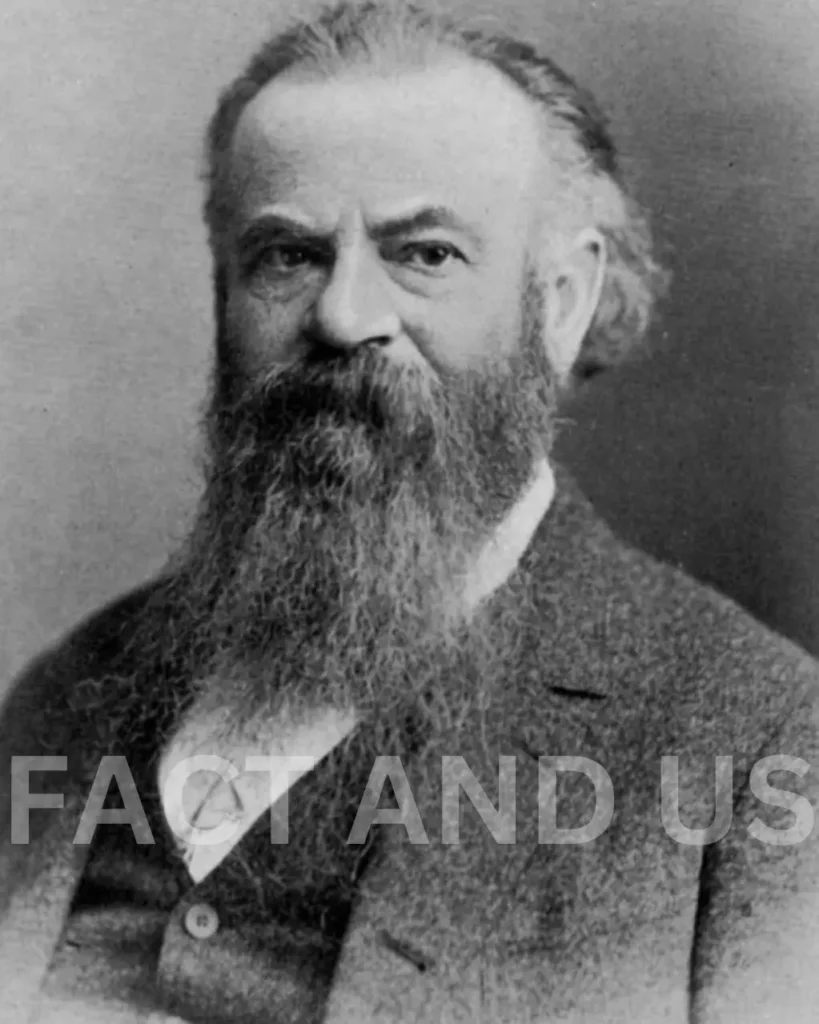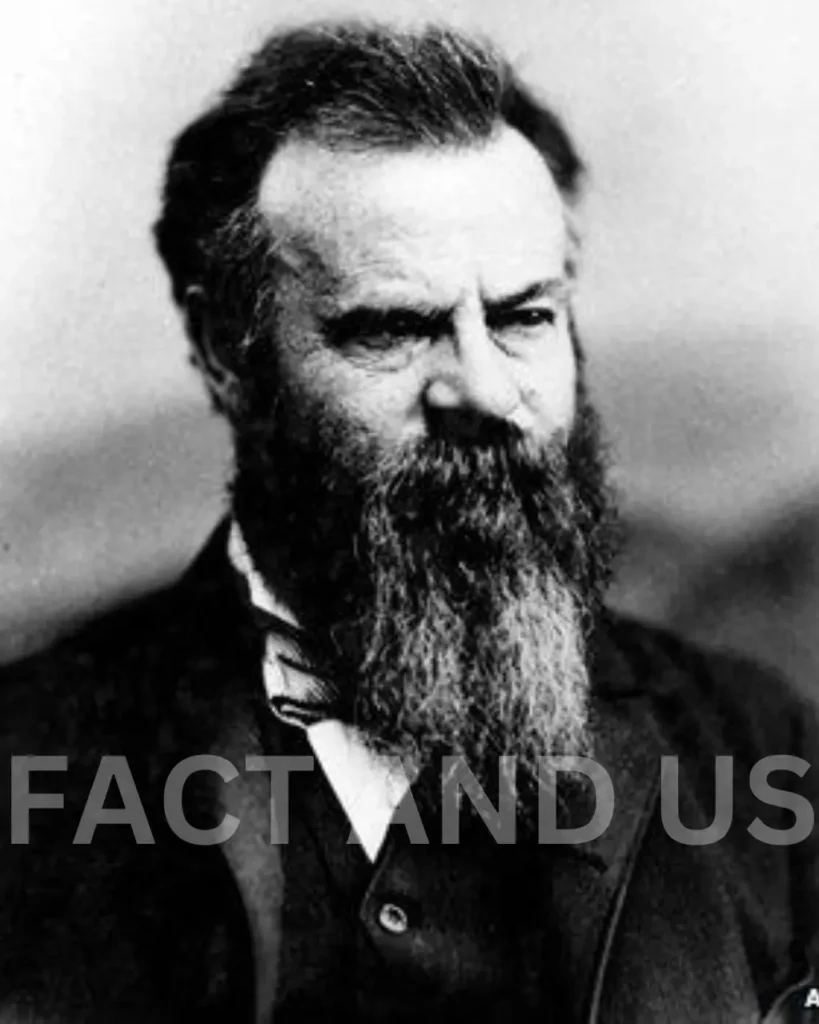
John Wesley Powell (March 24, 1834 – September 23, 1902) was an American geologist, U.S. Army soldier, explorer of the American West, professor at Illinois Wesleyan University, and director of major scientific and cultural institutions. He is famous for his 1869 Geographical Expedition, a three-month river journey down the Green and Colorado Rivers, which also included the first official US government-sponsored route through the Grand Canyon.
Powell was honored by US President James A. Garfield served as the second director of the U.S. Geological Survey (1881–1894) and proposed policies for the development of the arid West that were prescient in his accurate assessment of conditions. Two years before his service as Director of the U.S. Geological Survey, Major Powell had become the first Director of the Bureau of Ethnography at the Smithsonian Institution where he supported linguistic and sociolinguistic research and publications.
Contents
- 1 John Wesley Powell Personal life.
- 2 John Wesley Powell Early life and early exploration.
- 2.1 John Wesley Powell Colorado river expedition
- 2.2 John Wesley Powell Campaign
- 2.3 The first camp of the John Wesley Powell expedition, in the willows, Green River, Wyoming, 1871.
- 2.4 Members of the first Powell expedition were:
- 2.5 Award.
- 2.6 History Havasu Falls, Grand Canyon, northwestern Arizona, US.
John Wesley Powell Personal life.
On 28 November 1861, while serving as captain of Battery ‘F’ of the 2nd Illinois Light Artillery at Cape Girardeau, Missouri, he took a brief leave of absence to marry Emma Dean. :
On September 10, 1871, Emma Dean gave birth to the Powell only child, Mary Dean Powell, in Salt Lake City, Utah. [42] She was active in the National Women’s Club Wimodaughis in Washington, DC, which was started by Anna Howard Shaw and Susan B. Anthony. Emma Dean Powell died on March 13, 1924 in Washington, DC. She is buried with her husband in Arlington National Cemetery.
Powell studied at Illinois College, Illinois Institute (which later became Wheaton College), and Oberlin College over a period of seven years while teaching, but was unable to obtain his degree. During his studies Powell acquired knowledge of ancient Greek and Latin. Powell had a restless nature and a keen interest in the natural sciences.
This desire to learn about the natural sciences was against his father’s wishes, yet Powell was determined to do so. While Powell was on a lecture tour in 1861 he decided that civil war was inevitable; He decided to study military science and engineering to prepare himself for the impending conflict.
John Wesley Powell Early life and early exploration.

Powell was the fourth child of English immigrants Joseph Powell, a tailor, farmer and itinerant Methodist preacher, and Mary Deane, a missionary. In 1838 his parents moved the family from New York to southern Ohio, where Powell came under the tutelage of George Crookham, an amateur naturalist and scholar, who encouraged the young man’s interest in science, history, and literature.
The Powell family moved again in 1846, to South Grove, Wisconsin, where John was responsible for the care of the family farm while his father was away preaching. The family eventually settled in Illinois in 1851, and Powell became a school teacher there in 1852. For some time in the 1850s when he was not teaching, Powell taught at the Illinois Institute in Wheaton, Illinois College in Jacksonville, and the University of Ohio.
He attended college at Oberlin College, but did not receive a degree. In the late 1850s he led several self-financed expeditions along the Mississippi and Ohio Rivers, where he collected fossils and studied the natural history and geology of the areas.
Powell enlisted in the Union Army at the outbreak of the American Civil War and was soon commissioned as a second lieutenant. At the Battle of Shiloh in western Tennessee on April 6, 1862, Powell was struck in the right forearm by a Minié ball—a lead bullet with a conical head—and two days later field surgeons amputated the broken portion of the limb.
Powell recovered and spent the next year working as a recruiting officer in Illinois, during which time he lived at home with his new wife, Emma Dean Powell, the daughter of Mary Dean’s half-brother, whom he married in 1861. Was. Powell returned to active service in February 1863 and was later promoted to major. for the remainder of the war
When the war ended, Powell became professor of natural sciences at Illinois Wesleyan University in Bloomington. In 1866 he took up a teaching position at Illinois State Normal University in Normal, and in 1867 he became curator of the Illinois Natural History Society Museum. Possibly with Sherman’s encouragement
John Wesley Powell Colorado river expedition
In 1868 Powell organized another expedition, this time to trace the Colorado River from a tributary in the Wind River Mountains of Wyoming southward to its confluence with the Gulf of California in Mexico. Powell’s crew of 10 included hunters, trappers, and fellow Civil War veterans. They set out from Green River Station, Wyoming, on May 24, 1869, in four small boats.
In Lodore Canyon, Utah, one of the boats sank in a torrent, taking with it the scientific equipment and about one-quarter of the crew’s provisions. However, the team recovered some barometers, which were used to measure the height of the rock. The team reached a location in the Grand Canyon on August 5, which Powell named four days later, writing,Powell named several other features of the Grand Canyon during the trip, including Silver Creek (which he later renamed Bright Angel Creek).
Once inside the Grand Canyon, the party encountered several disasters, including the loss of much of the food left due to spoilage and the near sinking of the second boat, which was later abandoned. Powell wrote in his diary that the morale of his men was dangerously low. On August 28, three members of the party decided to abandon the expedition and head for the nearest American settlement, about 75 miles away.
All three were killed by members of the Shivwits band of Paiute people, who felt they were encroaching on Shivwits territory. The next day, Powell halted the expedition at the confluence of the Virgin and Colorado Rivers, an area now covered by present-day Lake Mead in Nevada.
John Wesley Powell Campaign
Powell returned to the Colorado River two years later, supported by an appropriation from the US Congress and an 11-man crew that included several trained scientists. The second trip (which lasted from May 22, 1871 to September 7, 1872) produced the first reliable maps of the Colorado River.
Powell described the events of both expeditions in his book Exploration of the Colorado River of the West and its Tributaries: Explored in 1869, 1870, 1871, and 1872 Under the Direction of the Secretary of the Smithsonian Institution (1875), also known as Canyon Reprinted as Of the Colorado (1895).
The first camp of the John Wesley Powell expedition, in the willows, Green River, Wyoming, 1871.
Powell (right) with Tau-gu, a Southern Paiute, 1871–1872.
After 1867, Powell led several expeditions into the Rocky Mountains and around the Green and Colorado Rivers. One of these expeditions was with his students and his wife, the purpose of which was to collect specimens throughout Colorado. Powell, William Byers and five others were the first white men to climb Longs Peak in 1868.
In 1869, he set out to explore the Colorado River and the Grand Canyon. Gathering ten men, four boats, and food for 10 months, he set out from Green River, Wyoming on May 24. Passing dangerous rapids, the group proceeded down the Green River to its confluence with the Colorado River (then also known as the Grand River upstream from the junction), near present-day Moab, Utah, and on August 30, Completed the journey in 1869.
Members of the first Powell expedition were:
John Wesley Powell, organizer and leader of the trip, prominent in the Civil War
John Colton “Jack” Sumner, hunter, trapper, soldier in the Civil War
William H. Dunn, hunter, trapper from Colorado
Walter H. Powell, Captain in the Civil War, brother of John
George Y. Bradley, Civil War lieutenant, campaign historian
Oramel Mr. Howland, printer, editor, hunter
Seneca Howland, soldier who was wounded at the Battle of Gettysburg
Frank Goodman, English adventurer
W.R. Hawkins, cook, soldier in the Civil War
Andrew Hall, Scotsman, youngest member of the expedition
Award.
An article in Scientific American mentions the following awards: [38]
1880 – Elected to the National Academy of Sciences [39]
1886 – Honorary Ph.D. from the University of Heidelberg on the 500th anniversary.
1886 – Honorary L.L.D. from Harvard University on the 230th Anniversary.
President of the Washington Anthropological Society 1879–1888
1884 – President of the Washington Philosophical Society
1874 – Elected a member and fellow of the American Association for the Advancement of Science (AAAS)
1875 – Vice President of AAAS
History Havasu Falls, Grand Canyon, northwestern Arizona, US.
The Grand Canyon at the foot of the Torowaweep, illustration by William Henry Holmes from Clarence E. Dutton’s Atlas with Monograph on the Tertiary History of the Grand Canyon District, 1882.
Several pueblos and cliff-dwelling ruins, together with accompanying artifacts, indicate prehistoric occupation.
The Grand Canyon is credited with being first seen by a European by the Francisco Coronado expedition of 1540 and then by two Spanish priests, Francisco Domínguez and Silvestre Vélez de Escalante, in 1776. Trappers investigated it in the early 1800s, and several expeditions sent by the U.S. government to explore and map the West began recording information about the valley.
The first known descent of the river by boat through the valley occurred in 1869, when an expedition to the area was led by geologist and ethnographer John Wesley Powell. Powell and others conducted follow-up expeditions to the region during the 1870s, and extensive reports on the geography, geology, botany, and anthropology of the area were published.
A portion of the canyon area was set aside as the Grand Canyon Forest Reserve by President Benjamin Harrison in 1893, and designated a game preserve (1903) and national monument by President Theodore Roosevelt before it was officially established by the U.S. Congress. (1908) Was redesignated as Grand Canyon National Park in 1919.
The park’s area was significantly expanded in 1975 by the addition of adjacent federal and other lands. In 1979 the park was designated a UNESCO World Heritage Site. It is an extremely popular tourist destination, visited by several million tourists every year.
Three Indian reservations (Navajo, Havasupai, and Hualapai) are adjacent to the Grand Canyon. The Kaibab National Forest borders the main part of the national park to the north and south, and the Grand Canyon-Parashant National Monument (designated 2000) borders the western part of the park, extending westward to the Nevada border.
Other public lands near the valley include Pipe Spring, Rainbow Bridge, and Grand Staircase-Escalante National Monument; Zion National Park; and Glen Canyon and Lake Mead National Recreation Areas.
Stay connected with Fact and US for more such news.

Thank you for your sharing. I am worried that I lack creative ideas. It is your article that makes me full of hope. Thank you. But, I have a question, can you help me?